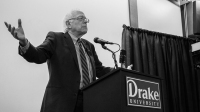By Vincent DeBellis

Bernie Sanders continues to hold the support of college students.
Bernie Sanders, Vermont senator and Democratic candidate for President of the United States in 2016, cares about the issues that are relevant to college students in America today. Creating decent paying jobs, racial justice, women’s rights, income inequality and climate change are all issues that speak directly to a generation of college students with more women and minorities than ever before in the United States. It makes sense that his main supporters are millennials that could have the power to change the outcome of the Democratic presidential nomination.
If elected, Sanders plans to increase the federal minimum wage to 15 dollars per hour by the year 2020, make tuition free at public universities and colleges throughout the United States, cut greenhouse gas emissions, create equal pay for men and women by signing the Paycheck Fairness Act into law, establish police forces that reflect the diversity of communities and require body cameras for law enforcement officials, among many other revolutionary ideas.
The changes to the country give young people the hope that there is a brighter, more sustainable future ahead.
Sanders’ wide range of experience in politics and social activism is invaluable as both a leader and a communicator. During his college years at the University of Chicago, Sanders was a civil rights activist, having marched on Washington at Martin Luther King Jr.’s historic “I Have a Dream” speech in 1963.
Sanders realizes how far race relations have come in half a century and knows that Dr. King’s work is still unfinished. Who better to lead the nation to true racial equality than someone present at the most influential racial march in American history?
After spending his earlier years as a documentary filmmaker and carpenter, Sanders got started in politics in 1981 when he was elected mayor of Burlington, Vermont by a margin of ten votes. Sanders has served in both the Senate and the House of Representatives since then, and passed more amendments than any other member of Congress during his time in the House.
Throughout a summer dominated by Donald Trump’s theatrics, Sanders has slowly but surely been eating away at Hilary Clinton’s once sizable lead in the Democratic polls. According to the Huffington Post, support for Sanders has been rising gradually but steadily since he announced his candidacy in May. On the other hand, Clinton’s numbers have been stagnant for the past year and a half.
A good deal of Sanders’ supporters are the college kids who are intrigued by the prospect of a political revolution and the possibility that public universities will be free of charge in the future. The term “political revolution” has worked to his advantage by enticing a younger demographic, excited to be on the cusp of a potentially groundbreaking movement.
The use of social media, particularly Twitter, has helped Sanders with the young adult population of voters.
Although Hilary Clinton has over four times the Twitter followers of Sanders, Sanders has tweeted nearly twice as much as Clinton, making his presence known to the young population on the social networking site. While Clinton often uses her social media presence to try to connect with younger voters through references to Internet trends, Sanders has been able to better to connect to youth by talking about policy changes college kids care about.
During the first two major Republican debates, Sanders trended on Twitter, interacting with users through use of the hashtag #DebateWithBernie. Sanders also uses the hashtag to critique what is going on at the Republican debate in live time.
After the debates, he criticized the Republicans for focusing on war and failing to mention foreign policy or climate change. This format allows for Sanders to participate in the debate without actually being there.
Success as president would be largely dependent on cooperation from Congress. In the Senate, Republicans are defending 24 seats in 2016, allowing much opportunity for Democrats, who need to net just five seats to gain the Senate majority. In order for Democrats to gain control of the House in 2016, they need to gain thirty seats, which is not likely, but also not impossible.
History has shown that House results have often aligned with outcomes of the presidential race, meaning that a Sanders victory, or any Democratic victory for that matter, would increase the likelihood for Democrats to take control of the House.
With that being said, the GOP are still large favorites to have control of the House in 2016, meaning that Sanders’ success in office would hinge on his ability to find a common ground with the Republicans who are opposed to his very liberal ideas. As we have seen with President Obama’s stagnated progress thanks largely to a Republican Congress, finding this compromise is much easier said than done.
Although this should not be a deciding factor, it is important to take this into consideration when voting next year. A radical president is great on paper, but if no meaningful legislation or changes come out of his tenure, then his hyped up campaign will make many Americans unhappy.
Hopefully, millennials will be encouraged to actually vote this election to make the difference they want to see happen.
Vincent DeBellis, FCRH’19, is a psychology major from Bergenfield, New Jersey.
